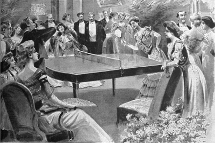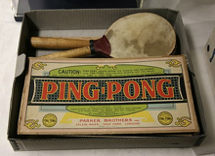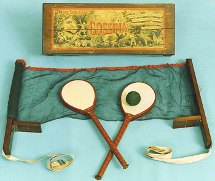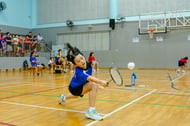When I was in secondary school, my classmates and I sometimes arranged to stay back after lessons to play table tennis. We didn�t use the specially provided tables in the school�s sports hall, or the ones at the nearby HDB void deck. Instead, we met in class and played multiple 11-point games until we got tired or chased out by a passing teacher (since we weren�t allowed to remain in the classrooms after lesson hours).
You might be wondering: �table tennis in the classroom?�
Yes. table tennis in the classroom! We shifted eight classroom desks (the usual square ones in your average classroom) and put them together to form a two-by-four rectangle.
Then, we slotted our school diaries in the middle of the rectangle to create a table tennis net. The result was a makeshift table tennis table, decorated with the occasional graffiti scribbles of bored students and a sprinkle of eraser dust. We brought our own rackets and table tennis balls.
I didn�t know it then, but in many respects, my friends and I were replicating the creation of table tennis itself. The sport first emerged as a form of entertainment in Victorian England (approx. 1837-1901) amongst the upper classes. After dinner, people would gather in the parlour, which was like an upper-class living room, and played the game on a dining table.
The first games were played using a row of books to form a net, while the corks of glass bottles were made into makeshift balls. Over time, the game became increasingly popular amongst the upper-class Victorians. 
Eventually, companies like J. Jaques and Son Ltd. (now called Jaques of London) and Parker Brothers sold specially manufactured equipment for the game. The first rackets included stringed versions - like the ones we use to play badminton today - and drum-like versions. The balls were made of either rubber or cork.
Eventually, companies like J. Jaques and Son Ltd. (now called Jaques of London) and Parker Brothers sold specially manufactured equipment for the game. The first rackets included stringed versions - like the ones we use to play badminton today - and drum-like versions. The balls were made of either rubber or cork.

In 1901, these balls came to be replaced by James Gibb�s invention of a celluloid plastic ball. Around the same time, E. C. Goode created a new version of the racket by attaching a sheet of rubber to a wooden base. These inventions have remained with us even till now.
Today, table tennis has grown in popularity to become one of the most widely played sport across the globe. Some estimates pin the number of players at as high as 300 million, though that number includes both professional and recreational players. In Singapore, many schools offer the sport as a formal co-curricular activity. There are also many local tournaments and training opportunities offered by organisations such as Singapore Table Tennis Association and the National Sports Association for table tennis. 
If you�re interested in trying out the game for yourself, recreational table tennis equipment can easily be found in some bookstores and supermarkets (usually their �Sport� or �Toys and Games� sections) for no more than $10 a set. The sport�s relative inexpensiveness as compared to other games like golf or softball may be one reason for its popularity, though professional equipment may easily cost more than $200.
Otherwise, there�s always the alternative of clearing the clutter in the dining room of your home and grabbing some books of similar sizes to form a net. As for rackets and balls, one may take the cue from the Victorians and use books (maybe cardboard?) and glass bottle corks respectively. Most importantly, simply let your creativity guide you in setting up and enjoying this original version of table tennis.
The article is based on the research of our YouthCreators.
Content by: Matthew Seah
References:
(2020). Retrieved 17 July 2020, from https://web.archive.org/web/20150313051738/http://www.ittf.com/museum/history.html
Digital, F. (2020). About Us | Singapore Table Tennis Association. Retrieved 17 July 2020, from https://www.stta.org.sg/about-us/
HuffPost is now a part of Verizon Media. (2020). Retrieved 17 July 2020, from https://www.huffingtonpost.ca/2012/07/27/table-tennis-pingpong-or_n_1709976.html?guccounter=1#:~:text=Victorians%20invented%20the%20parlour%20game,champagne%20corks%20%E2%80%94%20fashioned%20into%20balls.&text=%22Pingpong%20was%20invented%20on%20the,%2C%20pingpong%20is%20coming%20home.%22
Ping-Pong as Mind Game (Although a Good Topspin Helps). (2020). Retrieved 17 July 2020, from https://www.nytimes.com/2008/04/05/business/05pursuits.html
Players, B. (2020). Table Tennis Players. Retrieved 17 July 2020, from https://www.allabouttabletennis.com/table-tennis-players.html#:~:text=The%20number%20of%20table%20tennis,you%20know%20someone%20who%20does.
Table tennis. (2020). Retrieved 17 July 2020, from https://en.wikipedia.org/wiki/Table_tennis#History
What Are the Origins of Table Tennis?. (2020). Retrieved 17 July 2020, from https://www.liveabout.com/history-of-table-tennis-ping-pong-3173595
Related Articles
Related Topics
Recent Events & Programmes
Related Articles
Related Topics
Related Articles
View AllRelated Topics
[BlogPost 164438712123 NSG 2024 Badminton: Senior Div Girls Quarter-Finals, BlogPost 164238055490 Evergreen Aleksandar Duric Still Making Headlines at 53, BlogPost 164170080646 NSG 2024 Rope Skipping: Junior Div Girls Freestyle Team Finals, BlogPost 162884973666 Move and Rest Better With Data From Your Own Body, BlogPost 163393049482 Life Comes Full Circle For Serangoon Garden Secondary School's Fahrish Khan, BlogPost 163258797651 Making Golf a Sport for All, BlogPost 162512222328 NSG 2024 Sepaktakraw: Senior Div Yuhua Primary School vs Qihua Primary School, BlogPost 162233592997 Gritty Lions Suffer Loss to China, BlogPost 162089384371 On Your Mark, Get Ready, Go Running, BlogPost 161670652697 Lions' Excellent Showing Against China, BlogPost 161435270031 Ogura Optimistic for Exciting Clash against China, BlogPost 161127614758 The Future of Basketball in Singapore: Why 3x3 is Here to Stay, BlogPost 161033673012 The Active Lifestyler's Guide to the New ActiveSG Delta Sport Centre, BlogPost 161128356680 Grand New Champions Crowned at WTT Singapore Smash 2024, BlogPost 160844835218 NSG 2024 Table Tennis: C Div Boys Pool Round, BlogPost 160210745115 NSG 2024 Basketball: Senior Div Girls Tampines Primary School vs Frontier Primary School, BlogPost 159881180544 Whirlwind Return to Women's Football, BlogPost 159633541417 Singapore Smash to Elevate a New Legacy, BlogPost 158983580420 NSG 2024 Rugby: B Div Damai Secondary School vs Peirce Secondary School, BlogPost 159003960202 SFA Fiesta: Kicking off 2024 to a Roaring Start, BlogPost 158830735126 NSG 2024 Football: B Div Girls Preliminary Round Meridian Secondary School VS Bowen Secondary School, BlogPost 158536989718 Team Nila Volunteers Recognized At Awards Ceremony, BlogPost 158270107806 NSG 2024 Hockey: B Div Boys Preliminary Round Raffles Institution VS St. Hilda Secondary School, BlogPost 157966862615 NSG 2024 Floorball: B Division Preliminary Rounds Kick Off!, BlogPost 157562433712 What Is Safe Sport?, BlogPost 157559446197 Sengkang Secondary: Cultivating Well-Rounded Footballers, BlogPost 157368261167 New National Training Centre for Cricket at West Coast Ground, BlogPost 155340164987 Active Ageing with Joey Bonifacio, BlogPost 155930815517 Inaugural Singapore Youth League kicks off from 24th February 2024, BlogPost 155340164727 Bukit Canberra : the Coolest Spot in the North, BlogPost 155368905255 How Padang Fandi Inspired Ayden to Chase his Dream, BlogPost 154755572826 Ageing Backwards with Elizabeth Cheang, BlogPost 154094657315 Running For Fitness, BlogPost 153318636178 Excitement Builds for FIBA 3x3 Asia Cup 2024, BlogPost 153198644247 World's Top Four Confirmed for 2024 HSBC Women's World Championship, BlogPost 149413941770 Cultivating Your Kids’ Interest in the Outdoors, BlogPost 149413941163 Making Sport More Appealing for Our Kids, BlogPost 149412549409 Solo Or Team Sport – Choosing the Best for Your Child, BlogPost 151197478798 Former Lions Stalwart Baihakki Khaizan Sheds Light on New Accreditation to Elevate Grassroots Football and Youth Development, BlogPost 80703591291 New Year, Fitter You! Here are the top 3 workouts for the New Year, BlogPost 81171151456 7 Reasons Why Sports are Great for Children’s Mental Health, BlogPost 80542065330 17 Best Yoga Classes & Studios in Singapore [+ Rating & Prices], BlogPost 149404351798 From Brush to Lens: A Student's Journey in the World of Art and Sports Photography, BlogPost 149402825063 The Benefits of Active Parenting, BlogPost 149397832009 Sweden Claim 9th Straight Gold at the Women's World Floorball Championship, BlogPost 149397831449 Lion City Sailors Win 2023 Singapore Cup, BlogPost 148511324266 Pitch Perfect with Jonathan Teo, BlogPost 148511724402 Seniors: Increase your flexibility bit by bit with these stretches, BlogPost 147866574167 A Valuable Experience In Spain for Singapore's National Development Centre U-14 Boys, BlogPost 146915317264 How one magical Kallang night changed the lives of Abirami and Daania forever]








.jpg?width=162&height=60&name=2XURUN2024%20-%20KV%20(1920%20x%20700px).jpg)


